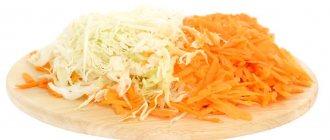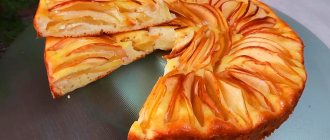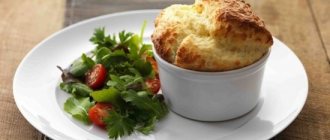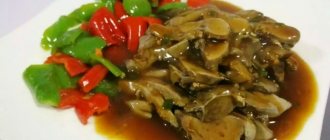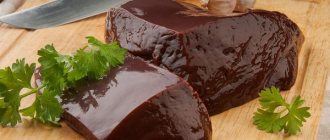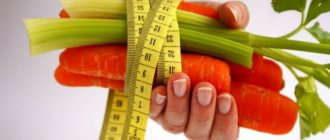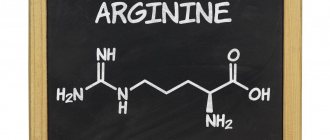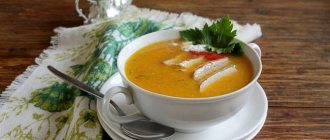Chicken liver is an incredibly healthy product, it has an interesting taste and tenderness, but only if it is prepared correctly. If the cook masters some rules for preparing a dish, he will make pate without difficulty. You can cook liver deliciously and elegantly using one of several options. In addition to tender chicken liver prepared according to the classic recipe, variations are available with white wine or turning the product into hearty cutlets. Chicken liver also makes a delicious liver cake. Every person knows that offal makes an excellent pate, especially if you flavor it with a properly selected bouquet of spices.
Homemade chicken liver pate is simply an ideal dish, since it is prepared once or twice and is sure to please everyone. Preparing a hearty and tasty dish is so simple that it can become a decoration of your everyday diet. If you decorate the pate in an original way or form it into a roll, it will become the highlight of any feast.
It’s really quick and easy to make an exquisite product from chicken liver that you wouldn’t be ashamed to offer to your guests. You should always stir the pâté mass exclusively with a wooden spoon, as metal gives it an unpleasant aftertaste. The snack has a delicate consistency, reminiscent of cream; it can be eaten as a snack, spread on fresh bread, toast or crouton.
Calorie content Liver pate, canned food. Chemical composition and nutritional value.
Nutritional value and chemical composition of “Liver pate, canned food”.
| Nutrient | Quantity | Norm** | % of the norm in 100 g | % of the norm in 100 kcal | 100% normal |
| Calorie content | 301 kcal | 1684 kcal | 17.9% | 5.9% | 559 g |
| Squirrels | 11.6 g | 76 g | 15.3% | 5.1% | 655 g |
| Fats | 28.1 g | 56 g | 50.2% | 16.7% | 199 g |
| Carbohydrates | 3.4 g | 219 g | 1.6% | 0.5% | 6441 g |
| Alimentary fiber | 0.2 g | 20 g | 1% | 0.3% | 10000 g |
| Water | 54.7 g | 2273 g | 2.4% | 0.8% | 4155 g |
| Ash | 2 g | ||||
| beta carotene | 0.531 mg | 5 mg | 10.6% | 3.5% | 942 g |
| Vitamin B1, thiamine | 0.14 mg | 1.5 mg | 9.3% | 3.1% | 1071 g |
| Vitamin B2, riboflavin | 1.1 mg | 1.8 mg | 61.1% | 20.3% | 164 g |
| Vitamin E, alpha tocopherol, TE | 0.8 mg | 15 mg | 5.3% | 1.8% | 1875 |
| Vitamin RR, NE | 7.4 mg | 20 mg | 37% | 12.3% | 270 g |
| Niacin | 5 mg | ||||
| Macronutrients | |||||
| Potassium, K | 170 mg | 2500 mg | 6.8% | 2.3% | 1471 g |
| Calcium, Ca | 11 mg | 1000 mg | 1.1% | 0.4% | 9091 g |
| Magnesium, Mg | 14 mg | 400 mg | 3.5% | 1.2% | 2857 g |
| Sodium, Na | 539 mg | 1300 mg | 41.5% | 13.8% | 241 g |
| Sera, S | 116 mg | 1000 mg | 11.6% | 3.9% | 862 g |
| Phosphorus, Ph | 244 mg | 800 mg | 30.5% | 10.1% | 328 g |
| Microelements | |||||
| Iron, Fe | 6.3 mg | 18 mg | 35% | 11.6% | 286 g |
| Digestible carbohydrates | |||||
| Mono- and disaccharides (sugars) | 0.4 g | max 100 g | |||
| Sterols (sterols) | |||||
| Cholesterol | 406 mg | max 300 mg | |||
| Saturated fatty acids | |||||
| Saturated fatty acids | 16 g | max 18.7 g |
The energy value of liver pate, canned food is 301 kcal.
Main source: Skurikhin I.M. and others. Chemical composition of food products. Read more.
** This table shows the average levels of vitamins and minerals for an adult. If you want to know the norms taking into account your gender, age and other factors, then use the “My Healthy Diet” application.
Chicken liver pate baked in the oven in a pot
Famous chefs claim that even the highest quality store-bought pate cannot compare with the homemade version. Juicy chicken liver pate, cooked in the oven in ceramic pots, is a little different from the usual dish. In spite of everything, it is worth paying special attention to those people who adore quick and simple pates.
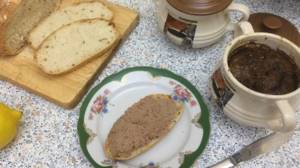
Products for cooking:
- 5 kg. chicken liver (preferably homemade, can be mixed with turkey in equal parts);
- 100 gr. onions;
- 2-3 cloves of garlic;
- 150 gr. carrots;
- 2 tbsp. l. + 70 gr. ghee or butter;
- ½ dessert spoon of salt;
- 1 tsp freshly ground black pepper;
- ½ tsp. nutmeg;
- 70 gr. heavy cream;
- 30 gr. ghee.
Preparation:
- Place lard, sliced garlic and diced onion in a hot frying pan. Sauté all the vegetables until golden brown, and after 3 minutes add carrots chopped into large slices.
- After 4-5 minutes of intense frying, add the liver, cut into pieces, to the vegetable frying. Add salt, ground spices, nutmeg, fry for 5 minutes.
- Cool the finished mixture and place it in a blender bowl. Throw in the cubed butter and pour in the cream. Blend everything in a blender for 1.5 minutes until it becomes a thick puree. If the blender is not powerful, then additionally rub the mass through a fine sieve.
- Transfer the resulting pate into a ceramic portion pot and carefully level the surface. Fill the remaining space with ghee.
- Place the pot in a metal container with water filled to halfway. Place everything in the oven, cook at a temperature of 120-130˚ for at least 40-50 minutes.
It is best to bake such a snack in glass jars or heat-resistant ramekins. You need to store the finished product in the refrigerator to avoid contracting botulism. The finished pate can be frozen; it will not lose its nutritional properties for a long time.
What are the benefits of liver pate, canned food?
- Vitamin A
is responsible for normal development, reproductive function, skin and eye health, and maintaining immunity. - Vitamin B2
is involved in redox reactions, helps to increase the color sensitivity of the visual analyzer and dark adaptation. Insufficient intake of vitamin B2 is accompanied by impaired condition of the skin, mucous membranes, and impaired light and twilight vision. - Vitamin PP
is involved in redox reactions of energy metabolism. Insufficient vitamin intake is accompanied by disruption of the normal condition of the skin, gastrointestinal tract and nervous system. - Phosphorus
takes part in many physiological processes, including energy metabolism, regulates acid-base balance, is part of phospholipids, nucleotides and nucleic acids, and is necessary for the mineralization of bones and teeth. Deficiency leads to anorexia, anemia, and rickets. - Iron
is part of proteins with various functions, including enzymes. Participates in the transport of electrons and oxygen, ensures the occurrence of redox reactions and activation of peroxidation. Insufficient consumption leads to hypochromic anemia, myoglobin deficiency atony of skeletal muscles, increased fatigue, myocardiopathy, and atrophic gastritis.
still hide
You can see a complete guide to the healthiest foods in the “My Healthy Diet” app.
- home
- Product composition
- Composition: beef and veal
- Chemical composition of “Liver pate, canned food”
Tags:
Liver pate, canned food calorie content 301 kcal, chemical composition, nutritional value, vitamins, minerals, benefits of Liver pate, canned food, calories, nutrients, beneficial properties Liver pate, canned food
Energy value, or calorie content
- this is the amount of energy released in the human body from food during the digestion process. The energy value of the product is measured in kilocalories (kcal) or kilojoules (kJ) per 100 grams. product. The kilocalorie used to measure the energy value of food is also called a food calorie, so when caloric content is reported in (kilo)calories, the prefix kilo is often omitted. You can see detailed energy value tables for Russian products here.
The nutritional value
— content of carbohydrates, fats and proteins in the product.
Nutritional value of food product
- a set of properties of a food product, in the presence of which the physiological needs of a person for the necessary substances and energy are satisfied.
Vitamins
, organic substances required in small quantities in the diet of both humans and most vertebrates. Vitamin synthesis is usually carried out by plants, not animals. A person's daily requirement for vitamins is only a few milligrams or micrograms. Unlike inorganic substances, vitamins are destroyed by strong heat. Many vitamins are unstable and are “lost” during cooking or food processing.
source
Calorie content of liver pate. Chemical composition and nutritional value.
Nutritional value and chemical composition of “liver pate”.
| Nutrient | Quantity | Norm** | % of the norm in 100 g | % of the norm in 100 kcal | 100% normal |
| Calorie content | 184.5 kcal | 1684 kcal | 11% | 6% | 913 g |
| Squirrels | 10 g | 76 g | 13.2% | 7.2% | 760 g |
| Fats | 14.5 g | 56 g | 25.9% | 14% | 386 g |
| Carbohydrates | 3.5 g | 219 g | 1.6% | 0.9% | 6257 g |
| Alimentary fiber | 0.2 g | 20 g | 1% | 0.5% | 10000 g |
| Water | 54.7 g | 2273 g | 2.4% | 1.3% | 4155 g |
| Ash | 2 g | ||||
| beta carotene | 0.531 mg | 5 mg | 10.6% | 5.7% | 942 g |
| Vitamin B1, thiamine | 0.14 mg | 1.5 mg | 9.3% | 5% | 1071 g |
| Vitamin B2, riboflavin | 1.1 mg | 1.8 mg | 61.1% | 33.1% | 164 g |
| Vitamin E, alpha tocopherol, TE | 0.8 mg | 15 mg | 5.3% | 2.9% | 1875 |
| Vitamin RR, NE | 7.4 mg | 20 mg | 37% | 20.1% | 270 g |
| Niacin | 5 mg | ||||
| Macronutrients | |||||
| Potassium, K | 170 mg | 2500 mg | 6.8% | 3.7% | 1471 g |
| Calcium, Ca | 11 mg | 1000 mg | 1.1% | 0.6% | 9091 g |
| Magnesium, Mg | 14 mg | 400 mg | 3.5% | 1.9% | 2857 g |
| Sodium, Na | 539 mg | 1300 mg | 41.5% | 22.5% | 241 g |
| Sera, S | 116 mg | 1000 mg | 11.6% | 6.3% | 862 g |
| Phosphorus, Ph | 244 mg | 800 mg | 30.5% | 16.5% | 328 g |
| Microelements | |||||
| Iron, Fe | 6.3 mg | 18 mg | 35% | 19% | 286 g |
| Digestible carbohydrates | |||||
| Mono- and disaccharides (sugars) | 0.4 g | max 100 g | |||
| Sterols (sterols) | |||||
| Cholesterol | 406 mg | max 300 mg | |||
| Saturated fatty acids | |||||
| Saturated fatty acids | 16 g | max 18.7 g |
The energy value of liver pate is 184.5 kcal.
Primary Source: Created in the application by the user. Read more.
** This table shows the average levels of vitamins and minerals for an adult. If you want to know the norms taking into account your gender, age and other factors, then use the “My Healthy Diet” application.
source
Production technology of meat and vegetable pate for dietary nutrition
The article discusses the production technology of deer meat pate with the addition of a protein fortifier intended for dietary nutrition. The value of deer meat in dietary nutrition has been analyzed. The results of chemical, organoleptic and microbiological evaluation of the product are presented.
Key words: meat and vegetable, deer, dietary nutrition, protein fortifier
In the modern world, in the production of meat products, non-traditional meat is increasingly used, for example, the meat of deer, rabbits, deer, turkeys, etc. In addition, protein-fat additives (BFA), protein additives, etc. are increasingly used .
Wild meat is a natural food that offers many benefits as they feed according to natural cycles, undergo natural selection, live freely and are stress-free.
In the production of dietary meat products today, deer meat is increasingly being used. Maral meat has good taste. As for the chemical composition, deer meat is somewhat different from the meat of farm animals familiar to us [1].
The calorie content of deer meat is 944–1154 kcal, the protein content is 18.31–20.14%, which is not inferior to beef or pork. But the mass fraction of fat in deer meat is less than in beef, lamb and pork, as is the cholesterol content.
In addition, deer meat is a rich source of vitamins A, B, C, E, macro- and microelements, such as iron, magnesium, zinc, copper, selenium, potassium and calcium [6, 7].
Secondary resources of meat production are valuable raw materials for the production of feed, medical and food products.
Another important ingredient in meat products is vegetable fillers. Plants are sources of polyunsaturated fatty acids, carbohydrates, vitamins and macro-microelements, as well as easily digestible proteins.
Today, meat-and-vegetable pate made from deer meat with the addition of a protein fortifier, intended for dietary nutrition, is becoming increasingly popular among nutritionists. The pate recipe includes deer meat (chopped), boiled chopped beans, protein fortifier, broth from cooking offal, carrots, wheat flour and spices [2].
Let us consider the technology for producing deer meat pate with the addition of a protein fortifier in more detail. At the first stage, the deer meat is washed and cut into pieces of 100–150 g. Then the meat is blanched in water at a temperature of 90–95 Cº for 30 minutes, after which the meat is crushed on a grinder with a grid hole diameter of 2–3 mm.
The beans are washed and boiled in water for 30 minutes, after which they are chopped. Carrots undergo the same treatment. The protein fortifier, spices and broth are pre-prepared and weighed.
All components are mixed in the cutter with sequential loading of raw materials: first of all, chopped deer meat is loaded, then protein fortifier, wheat flour, salt, spices and vegetables are added. The total cutting time is 8 minutes.
After cutting, the pate mass is extruded into a natural shell. The finished loaves are cooked in steam chambers for 60 minutes at a temperature of 85 Cº. Cooking is considered complete when the temperature in the center of the loaf reaches 72 Cº [3].
Table 1 presents the chemical composition of deer meat pate with the addition of a protein fortifier intended for dietary nutrition.
Table 1
Chemical composition of deer meat pate with the addition of a protein fortifier
| Indicators | Content, % |
| Moisture | 74,8 |
| Protein | 19,63 |
| Fat | 2,31 |
| Ash | 2,15 |
| Energy value, kcal | 99,93 |
The organoleptic evaluation of deer meat pate with the addition of a protein fortifier intended for dietary nutrition is presented in Table 2.
table 2
Organoleptic evaluation of deer meat pate with the addition of a protein fortifier
| Indicators | Grade |
| Appearance | 4,7 |
| Color | 4,9 |
| Smell | 4,9 |
| Consistency | 4,8 |
| Taste | 4,7 |
| final grade | 4,8 |
Table 3 shows the microbiological characteristics of deer meat pate with the addition of a protein fortifier intended for dietary nutrition.
Table 3
Microbiological characteristics of deer meat pate with the addition of a protein fortifier
| Indicators | Content |
| KMAFAnM, CFU/g | 8 x 101 |
| Coli bacteria | not detected |
| Sulfite-reducing clostridia, 0.1 g. | not detected |
| S.aureus at 0.1 g. | not detected |
| L. monocytogees | not detected |
Thus, deer meat pate with the addition of a protein fortifier has a low fat content and low calorie content and can be used in dietary nutrition.
Literature:
- Okuskhanova E.K. Development of recipes and technology for meat-and-vegetable pate using a protein fortifier // Innovative education and economics. — 2021. — No. 1. — P. 51–58.
- Vershinina A.G. Development of meat and vegetable pates for healthy nutrition // Equipment and technology of food production. - 2018. - No. 4. - P. 104–109.
- Gaptar S. L. Improving the production technology of meat-and-vegetable pate for dietary nutrition // Equipment and technology of food production. - 2021. - No. 11. - P. 302–308.
Liver pate - good or bad?
Despite the controversy: is pate healthy? We all probably know such a dish as pate. It is prepared from various animal products, including raw meat and fat. Traditional pate consists of liver (beef, goose, chicken, etc.). Its creamy texture allows it to be used for making sandwiches and other snacks.
Pate is a fairly popular product among the residents of our country, but have any of them ever thought about the benefits and harms of this delicacy? Let's figure out what are the benefits of regularly eating pate?
Organic meats are generally quite filling, but liver is by far the most nutritious. Contrary to popular belief, the liver is not a toxin storage organ. Rather, it is a detoxifying organ that flushes out toxins. What is stored in the liver is a storehouse of vital minerals, nutrients, amino acids and omega-3s. Accordingly, the pate will include the following components:
— Vitamin A: First of all, the liver is the most concentrated source of vitamin A. Although a person can get a lot of vitamin A from vegetables, the body needs fat, which pate can provide. Vitamin A helps with vision, maintains normal blood pressure and is important for the repair of skin cells. — Vitamin B-12 is found in large quantities in the liver. B-12 is involved in the synthesis of DNA and red blood cells, and is vital for people suffering from anemia. — Vitamin B9. It is essential for women as it promotes proper reproductive function and healthy fetal growth during pregnancy. B9 also prevents some digestive disorders. The pate is also rich in minerals: - Calcium, which is important for bone health. - Iron, which helps maintain muscle strength and oxygen transport. - Copper, which is important for blood health. - Magnesium, which regulates blood pressure and blood sugar levels. - Zinc, which is important for a healthy immune system.
As with other products, there are some drawbacks to pate. This applies if you eat too much of it. In addition to being high in saturated fat, it also has high cholesterol levels, which can be harmful to people with heart disease. If you eat pate, you should definitely stick to the rule of "eating in moderation" and only consume it once or twice a week. Dear customers, we remind you that the liver pate of the Pskov meat processing plant is prepared without soy and is not expensive. Don't forget about this useful product.
Ingredients: beef liver, pork, broth, starch, onion, salt, sugar, spices.
source
Chicken liver pate with mushrooms and butter
Another interesting recipe that is easy to implement is a paste made from chicken liver, mushrooms and butter. The finished dish turns out so tasty that you want to repeat it again and again to please your loved ones. The pate attracts with the delicate aroma of mushrooms and fried liver; it comes out exquisite, as if in the best houses of Paris.

List of required products:
- chicken liver – 250-300 gr.;
- onion – 1 medium;
- carrots – 1;
- fresh mushrooms – 250-300 gr.;
- full-fat milk or cream – 100 g;
- butter – 50 gr.;
- sunflower oil for frying – 100 g;
- granulated sugar – ½ tsp;
- boiled chicken eggs – 2;
- favorite spices;
- table salt - to taste;
- parsley or dill - a small bunch.
Preparation:
Cut the liver into small pieces, removing veins, blood clots or bile.
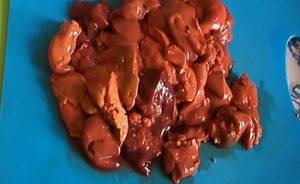
Cut mushrooms (champignons, oyster mushrooms) into small pieces.
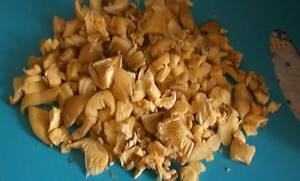
Chop the onion and grate the carrots on a coarse grater.
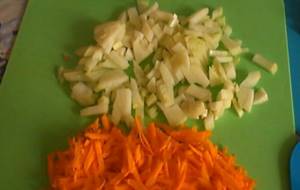
Fry the mushroom pieces in vegetable oil in one frying pan until they change color. Pour a little water into them so that they become soft faster, and simmer under the lid.
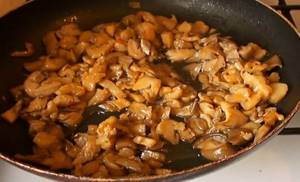
In a second frying pan, fry the onions and carrots in the second half of the vegetable oil until they turn golden. Add the liver to the vegetable mixture and fry for about 10-15 minutes.

To the fried liver add most of the fried mushrooms, salt, herbs, sugar, and seasonings. We put some champignons or oyster mushrooms in a separate container. Puree the rest of the mixture, chicken eggs, cut in half, in a blender.
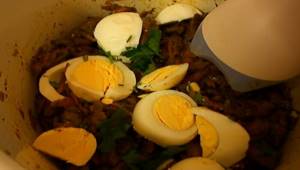
The resulting pate is carefully diluted with pre-boiled milk to the desired consistency. Add butter and set aside mushrooms, turned into crumbs separately, to the finished appetizer.
The best mushroom option for baked pate would be champignons or some wild mushrooms. The appetizer is served on a piece of fresh bread, biscuit or cracker. Such a delicacy can be perfectly stored in an airtight glass container, but for no more than 3 days in the refrigerator.
Ingredients Liver pate
| Carrots, red (Baked) | 120 g |
| Bulb onions | 120 g |
| Garlic bulb | 2 g |
| Beef liver (Cooking without draining) | 300 g |
| Chicken breast (fillet) (Cooking) | 330 g |
Nutritional value and chemical composition of “Liver pate”.
| Nutrient | Quantity | Norm** | % of the norm in 100 g | % of the norm in 100 kcal | 100% normal |
| Calorie content | 115.9 kcal | 1684 kcal | 6.9% | 6% | 1453 g |
| Squirrels | 20.5 g | 76 g | 27% | 23.3% | 371 g |
| Fats | 2.2 g | 56 g | 3.9% | 3.4% | 2545 g |
| Carbohydrates | 3.4 g | 219 g | 1.6% | 1.4% | 6441 g |
| Organic acids | 0.1 g | ||||
| Alimentary fiber | 1 g | 20 g | 5% | 4.3% | 2000 g |
| Water | 74 g | 2273 g | 3.3% | 2.8% | 3072 g |
| Vitamins | |||||
| Vitamin A, RE | 2510.2 mcg | 900 mcg | 278.9% | 240.6% | 36 g |
| beta carotene | 2.319 mg | 5 mg | 46.4% | 40% | 216 g |
| Vitamin B1, thiamine | 0.12 mg | 1.5 mg | 8% | 6.9% | 1250 g |
| Vitamin B2, riboflavin | 0.709 mg | 1.8 mg | 39.4% | 34% | 254 g |
| Vitamin B4, choline | 365.47 mg | 500 mg | 73.1% | 63.1% | 137 g |
| Vitamin B5, pantothenic | 3.988 mg | 5 mg | 79.8% | 68.9% | 125 g |
| Vitamin B6, pyridoxine | 0.678 mg | 2 mg | 33.9% | 29.2% | 295 g |
| Vitamin B9, folates | 128.11 mcg | 400 mcg | 32% | 27.6% | 312 g |
| Vitamin B12, cobalamin | 30.844 mcg | 3 mcg | 1028.1% | 887.1% | 10 g |
| Vitamin C, ascorbic acid | 8.01 mg | 90 mg | 8.9% | 7.7% | 1124 g |
| Vitamin D, calciferol | 0.61 mcg | 10 mcg | 6.1% | 5.3% | 1639 g |
| Vitamin E, alpha tocopherol, TE | 0.693 mg | 15 mg | 4.6% | 4% | 2165 g |
| Vitamin H, biotin | 55.619 mcg | 50 mcg | 111.2% | 95.9% | 90 g |
| Vitamin K, phylloquinone | 4.3 mcg | 120 mcg | 3.6% | 3.1% | 2791 g |
| Vitamin RR, NE | 12.9108 mg | 20 mg | 64.6% | 55.7% | 155 g |
| Macronutrients | |||||
| Potassium, K | 249.39 mg | 2500 mg | 10% | 8.6% | 1002 g |
| Calcium, Ca | 20.43 mg | 1000 mg | 2% | 1.7% | 4895 g |
| Magnesium, Mg | 51.87 mg | 400 mg | 13% | 11.2% | 771 g |
| Sodium, Na | 40.98 mg | 1300 mg | 3.2% | 2.8% | 3172 g |
| Sera, S | 240 mg | 1000 mg | 24% | 20.7% | 417 g |
| Phosphorus, Ph | 198.6 mg | 800 mg | 24.8% | 21.4% | 403 g |
| Chlorine, Cl | 111.92 mg | 2300 mg | 4.9% | 4.2% | 2055 g |
| Microelements | |||||
| Bor, B | 81.4 mcg | ||||
| Iron, Fe | 3.669 mg | 18 mg | 20.4% | 17.6% | 491 g |
| Yod, I | 8.22 mcg | 150 mcg | 5.5% | 4.7% | 1825 |
| Cobalt, Co | 18.285 mcg | 10 mcg | 182.9% | 157.8% | 55 g |
| Manganese, Mn | 0.261 mg | 2 mg | 13.1% | 11.3% | 766 g |
| Copper, Cu | 2008.71 mcg | 1000 mcg | 200.9% | 173.3% | 50 g |
| Molybdenum, Mo | 60 mcg | 70 mcg | 85.7% | 73.9% | 117 g |
| Selenium, Se | 20.255 mcg | 55 mcg | 36.8% | 31.8% | 272 g |
| Fluorine, F | 207.15 mcg | 4000 mcg | 5.2% | 4.5% | 1931 |
| Chromium, Cr | 22.32 mcg | 50 mcg | 44.6% | 38.5% | 224 g |
| Zinc, Zn | 3.9495 mg | 12 mg | 32.9% | 28.4% | 304 g |
| Sterols (sterols) | |||||
| Cholesterol | 137.3 mg | max 300 mg |
The energy value of Liver pate is 115.9 kcal.
Primary Source: Created in the application by the user. Read more.
** This table shows the average levels of vitamins and minerals for an adult. If you want to know the norms taking into account your gender, age and other factors, then use the “My Healthy Diet” application.
Chicken pate in a slow cooker
A multicooker is a modern kitchen equipment that every housewife has. It makes the cooking process much easier. In addition to the usual dishes, you can cook chicken pate in it.

youtu.be/JeDORkrylkw
Number of products:
- 600 g liver;
- 120 g onions and carrots;
- 100 g butter;
- salt, pepper, nutmeg and vegetable oil.
Hardening time – 1 hour.
Step-by-step action plan.
Step 1. Rinse the chicken product, remove debris and dry. Cut into small pieces. Scald with boiling water.
Step 2. Cut the peeled vegetables into small cubes. Pour oil into the slow cooker and add these products. Turn on the “Manual” mode, set the time to 45 minutes and temperature to 160°C.
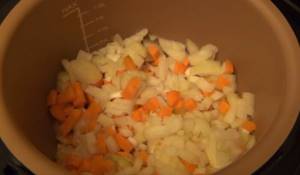
Step 3. After 20 minutes of simmering, add the liver and season with seasonings to taste. Pour in a tablespoon of water.
Step 4. When time is up, transfer to a separate container without excess moisture. Add the butter and blend until smooth using a blender.

Cover the resulting mass with a lid. Place in a cool place until hardened. This will take at least 1 hour (depending on the volume of the pate), but the longer the better.
What are the benefits of liver pate?
- Vitamin A
is responsible for normal development, reproductive function, skin and eye health, and maintaining immunity. - B-carotene
is provitamin A and has antioxidant properties. 6 mcg of beta carotene is equivalent to 1 mcg of vitamin A. - Vitamin B2
is involved in redox reactions, helps to increase the color sensitivity of the visual analyzer and dark adaptation. Insufficient intake of vitamin B2 is accompanied by impaired condition of the skin, mucous membranes, and impaired light and twilight vision. - Choline
is part of lecithin, plays a role in the synthesis and metabolism of phospholipids in the liver, is a source of free methyl groups, and acts as a lipotropic factor. - Vitamin B5
is involved in protein, fat, carbohydrate metabolism, cholesterol metabolism, the synthesis of a number of hormones, hemoglobin, promotes the absorption of amino acids and sugars in the intestines, and supports the function of the adrenal cortex. A lack of pantothenic acid can lead to damage to the skin and mucous membranes. - Vitamin B6
is involved in maintaining the immune response, processes of inhibition and excitation in the central nervous system, in the transformation of amino acids, the metabolism of tryptophan, lipids and nucleic acids, promotes the normal formation of red blood cells, and maintaining normal levels of homocysteine in the blood. Insufficient intake of vitamin B6 is accompanied by decreased appetite, impaired skin condition, and the development of homocysteinemia and anemia. - Vitamin B9
as a coenzyme is involved in the metabolism of nucleic acids and amino acids. Folate deficiency leads to disruption of the synthesis of nucleic acids and proteins, resulting in inhibition of cell growth and division, especially in rapidly proliferating tissues: bone marrow, intestinal epithelium, etc. Insufficient folate intake during pregnancy is one of the causes of prematurity, malnutrition, and congenital deformities and child development disorders. A strong relationship has been shown between folate and homocysteine levels and the risk of cardiovascular disease. - Vitamin B12
plays an important role in the metabolism and transformation of amino acids. Folate and vitamin B12 are interconnected vitamins that are involved in hematopoiesis. A lack of vitamin B12 leads to the development of partial or secondary folate deficiency, as well as anemia, leukopenia, and thrombocytopenia. - Vitamin H
is involved in the synthesis of fats, glycogen, and amino acid metabolism. Insufficient consumption of this vitamin can lead to disruption of the normal condition of the skin. - Vitamin PP
is involved in redox reactions of energy metabolism. Insufficient vitamin intake is accompanied by disruption of the normal condition of the skin, gastrointestinal tract and nervous system. - Magnesium
is involved in energy metabolism, the synthesis of proteins, nucleic acids, has a stabilizing effect on membranes, and is necessary to maintain the homeostasis of calcium, potassium and sodium. A lack of magnesium leads to hypomagnesemia, an increased risk of developing hypertension and heart disease. - Phosphorus
takes part in many physiological processes, including energy metabolism, regulates acid-base balance, is part of phospholipids, nucleotides and nucleic acids, and is necessary for the mineralization of bones and teeth. Deficiency leads to anorexia, anemia, and rickets. - Iron
is part of proteins with various functions, including enzymes. Participates in the transport of electrons and oxygen, ensures the occurrence of redox reactions and activation of peroxidation. Insufficient consumption leads to hypochromic anemia, myoglobin deficiency atony of skeletal muscles, increased fatigue, myocardiopathy, and atrophic gastritis. - Cobalt
is part of vitamin B12. Activates enzymes of fatty acid metabolism and folic acid metabolism. - Manganese
is involved in the formation of bone and connective tissue, and is part of enzymes involved in the metabolism of amino acids, carbohydrates, and catecholamines; necessary for the synthesis of cholesterol and nucleotides. Insufficient consumption is accompanied by slower growth, disturbances in the reproductive system, increased fragility of bone tissue, and disturbances in carbohydrate and lipid metabolism. - Copper
is part of enzymes that have redox activity and are involved in the metabolism of iron, stimulates the absorption of proteins and carbohydrates. Participates in the processes of providing oxygen to the tissues of the human body. Deficiency is manifested by disturbances in the formation of the cardiovascular system and skeleton, and the development of connective tissue dysplasia. - Molybdenum
is a cofactor for many enzymes that ensure the metabolism of sulfur-containing amino acids, purines and pyrimidines. - Selenium
is an essential element of the antioxidant defense system of the human body, has an immunomodulatory effect, and is involved in the regulation of the action of thyroid hormones. Deficiency leads to Kashin-Beck disease (osteoarthritis with multiple deformities of the joints, spine and limbs), Keshan disease (endemic myocardiopathy), and hereditary thrombasthenia. - Chromium
is involved in the regulation of blood glucose levels, enhancing the effect of insulin. Deficiency leads to decreased glucose tolerance. - Zinc
is part of more than 300 enzymes and is involved in the processes of synthesis and breakdown of carbohydrates, proteins, fats, nucleic acids and in the regulation of the expression of a number of genes. Insufficient consumption leads to anemia, secondary immunodeficiency, liver cirrhosis, sexual dysfunction, and the presence of fetal malformations. Research in recent years has revealed the ability of high doses of zinc to disrupt the absorption of copper and thereby contribute to the development of anemia.
still hide
You can see a complete guide to the healthiest foods in the “My Healthy Diet” app.
source
Liver pate ingredients
| Pork liver (Cooking without draining) | 700 g |
| Chicken egg (hard-boiled) | 220 g |
| Yogurt 3.2% fat | 100 g |
| Granulated sugar | 5 g |
| Table salt | 9 g |
| Carrots, red (Cook without draining) | 130 g |
| Onions (Cook without draining) | 230 g |
boil the liver, simmer the onions and carrots in a frying pan with a little oil (you can add more water to stew better and faster), mix the liver, boiled eggs, onions and carrots and blend everything with a blender, add sugar, salt and pepper, add for a soft consistency unsweetened yogurt
Nutritional value and chemical composition of “liver pate”.
| Nutrient | Quantity | Norm** | % of the norm in 100 g | % of the norm in 100 kcal | 100% normal |
| Calorie content | 105.6 kcal | 1684 kcal | 6.3% | 6% | 1595 g |
| Squirrels | 15.2 g | 76 g | 20% | 18.9% | 500 g |
| Fats | 4.8 g | 56 g | 8.6% | 8.1% | 1167 g |
| Carbohydrates | 3.5 g | 219 g | 1.6% | 1.5% | 6257 g |
| Organic acids | 0.2 g | ||||
| Alimentary fiber | 1 g | 20 g | 5% | 4.7% | 2000 g |
| Water | 76 g | 2273 g | 3.3% | 3.1% | 2991 g |
| Vitamins | |||||
| Vitamin A, RE | 1476.2 mcg | 900 mcg | 164% | 155.3% | 61 g |
| beta carotene | 1.458 mg | 5 mg | 29.2% | 27.7% | 343 g |
| Vitamin B1, thiamine | 0.147 mg | 1.5 mg | 9.8% | 9.3% | 1020 g |
| Vitamin B2, riboflavin | 1.018 mg | 1.8 mg | 56.6% | 53.6% | 177 g |
| Vitamin B4, choline | 410.45 mg | 500 mg | 82.1% | 77.7% | 122 g |
| Vitamin B5, pantothenic | 4.326 mg | 5 mg | 86.5% | 81.9% | 116 g |
| Vitamin B6, pyridoxine | 0.411 mg | 2 mg | 20.6% | 19.5% | 487 g |
| Vitamin B9, folates | 158.168 mcg | 400 mcg | 39.5% | 37.4% | 253 g |
| Vitamin B12, cobalamin | 20.618 mcg | 3 mcg | 687.3% | 650.9% | 15 g |
| Vitamin C, ascorbic acid | 5.51 mg | 90 mg | 6.1% | 5.8% | 1633 g |
| Vitamin D, calciferol | 0.472 mcg | 10 mcg | 4.7% | 4.5% | 2119 g |
| Vitamin E, alpha tocopherol, TE | 0.497 mg | 15 mg | 3.3% | 3.1% | 3018 g |
| Vitamin H, biotin | 59.122 mcg | 50 mcg | 118.2% | 111.9% | 85 g |
| Vitamin K, phylloquinone | 1.7 mcg | 120 mcg | 1.4% | 1.3% | 7059 g |
| Vitamin RR, NE | 12.8947 mg | 20 mg | 64.5% | 61.1% | 155 g |
| Macronutrients | |||||
| Potassium, K | 210.1 mg | 2500 mg | 8.4% | 8% | 1190 g |
| Calcium, Ca | 41.9 mg | 1000 mg | 4.2% | 4% | 2387 g |
| Magnesium, Mg | 22.53 mg | 400 mg | 5.6% | 5.3% | 1775 g |
| Sodium, Na | 410.05 mg | 1300 mg | 31.5% | 29.8% | 317 g |
| Sera, S | 184.86 mg | 1000 mg | 18.5% | 17.5% | 541 g |
| Phosphorus, Ph | 235.5 mg | 800 mg | 29.4% | 27.8% | 340 g |
| Chlorine, Cl | 634.96 mg | 2300 mg | 27.6% | 26.1% | 362 g |
| Microelements | |||||
| Bor, B | 70.2 mcg | ||||
| Iron, Fe | 11.858 mg | 18 mg | 65.9% | 62.4% | 152 g |
| Yod, I | 15.41 mcg | 150 mcg | 10.3% | 9.8% | 973 g |
| Cobalt, Co | 11.935 mcg | 10 mcg | 119.4% | 113.1% | 84 g |
| Manganese, Mn | 0.2687 mg | 2 mg | 13.4% | 12.7% | 744 g |
| Copper, Cu | 2097.12 mcg | 1000 mcg | 209.7% | 198.6% | 48 g |
| Molybdenum, Mo | 61.218 mcg | 70 mcg | 87.5% | 82.9% | 114 g |
| Selenium, Se | 42.96 mcg | 55 mcg | 78.1% | 74% | 128 g |
| Fluorine, F | 27.66 mcg | 4000 mcg | 0.7% | 0.7% | 14461 g |
| Chromium, Cr | 1.88 mcg | 50 mcg | 3.8% | 3.6% | 2660 g |
| Zinc, Zn | 3.2525 mg | 12 mg | 27.1% | 25.7% | 369 g |
| Sterols (sterols) | |||||
| Cholesterol | 211.8 mg | max 300 mg |
The energy value of liver pate is 105.6 kcal.
Primary Source: Created in the application by the user. Read more.
** This table shows the average levels of vitamins and minerals for an adult. If you want to know the norms taking into account your gender, age and other factors, then use the “My Healthy Diet” application.
Homemade recipe for chicken liver pate with butter
Liver pate for this version of the recipe is prepared on the basis of fresh liver, as well as sliced vegetables, fried in refined vegetable oil. This allows you to complement the natural taste of the offal; you must add high-quality butter to the dish. This ingredient helps make the mass soft, elastic, juicy, so it can be easily spread on a piece of fresh bread.
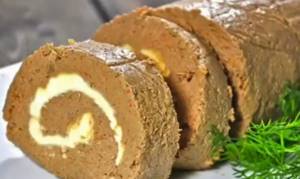
We will need:
- 5 kg. chicken liver;
- 3 large onions;
- 2 carrots;
- 180 gr. butter;
- 4-5 tbsp. l. sunflower oil;
- 3 tbsp. l. soy sauce;
- salt and ground pepper - in any quantity.
Step-by-step preparation:
- Heat a deep frying pan with a thick bottom, pour vegetable oil into it. Add the diced onion and fry over low heat until intensely yellow, stirring constantly with a wooden spatula.
- When the onion is fried until almost ready, add carrots grated on a coarse grater. After 4-5 minutes, put the washed liver in a frying pan, fry over medium heat for about 15 minutes, remembering to stir the mass.
- A few minutes before readiness, salt and pepper the liver-vegetable mass to taste. Then, while stirring, soy sauce is poured in and the dish is cooked until ready.
- Transfer the mixture to a separate glass container and add ½ of the specified piece of butter. Everything is thoroughly mixed and turned into puree using a blender.
- Once the pate has cooled to room temperature, transfer it to a board covered with cling film. The mass is spread over it with a silicone spatula into a layer 1.5 centimeters thick, forming a rectangular layer.
- Place pieces of the second half of butter in the center and wrap it up. Form candy-shaped ends from cling film and place the finished product in the refrigerator for 2-3 hours.
Vegetables will make the finished dish much juicier, significantly changing its color. Chicken liver pate with butter is a completely independent dish. It can be served on toast, after cooling a little in the refrigerator.


